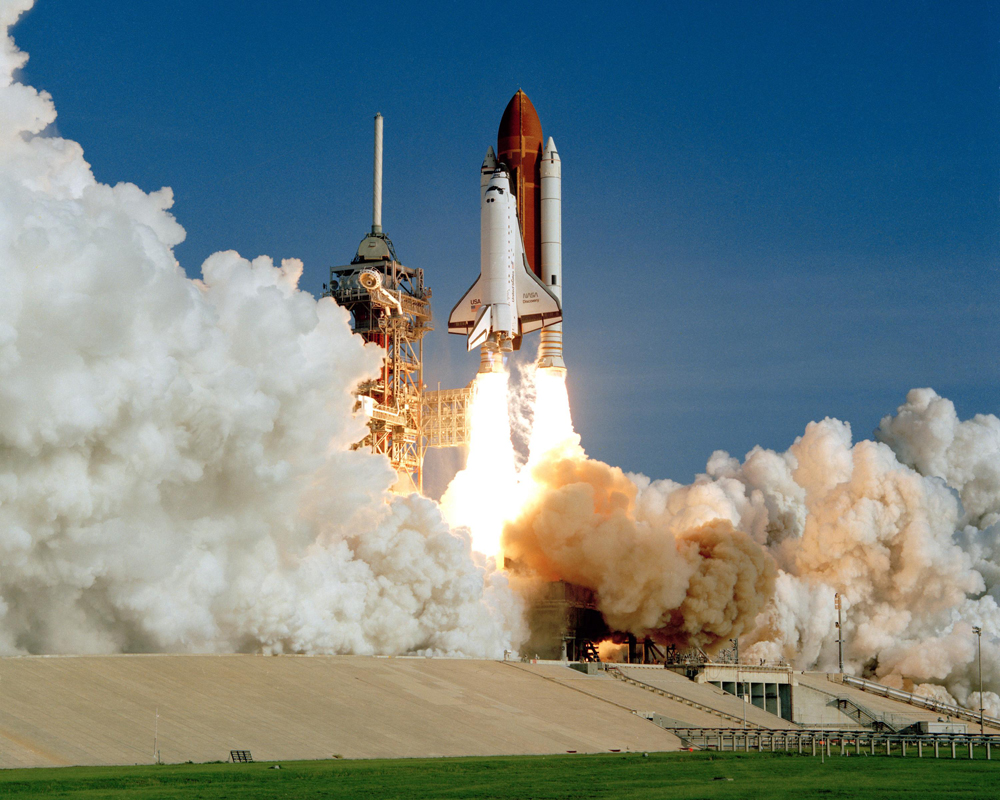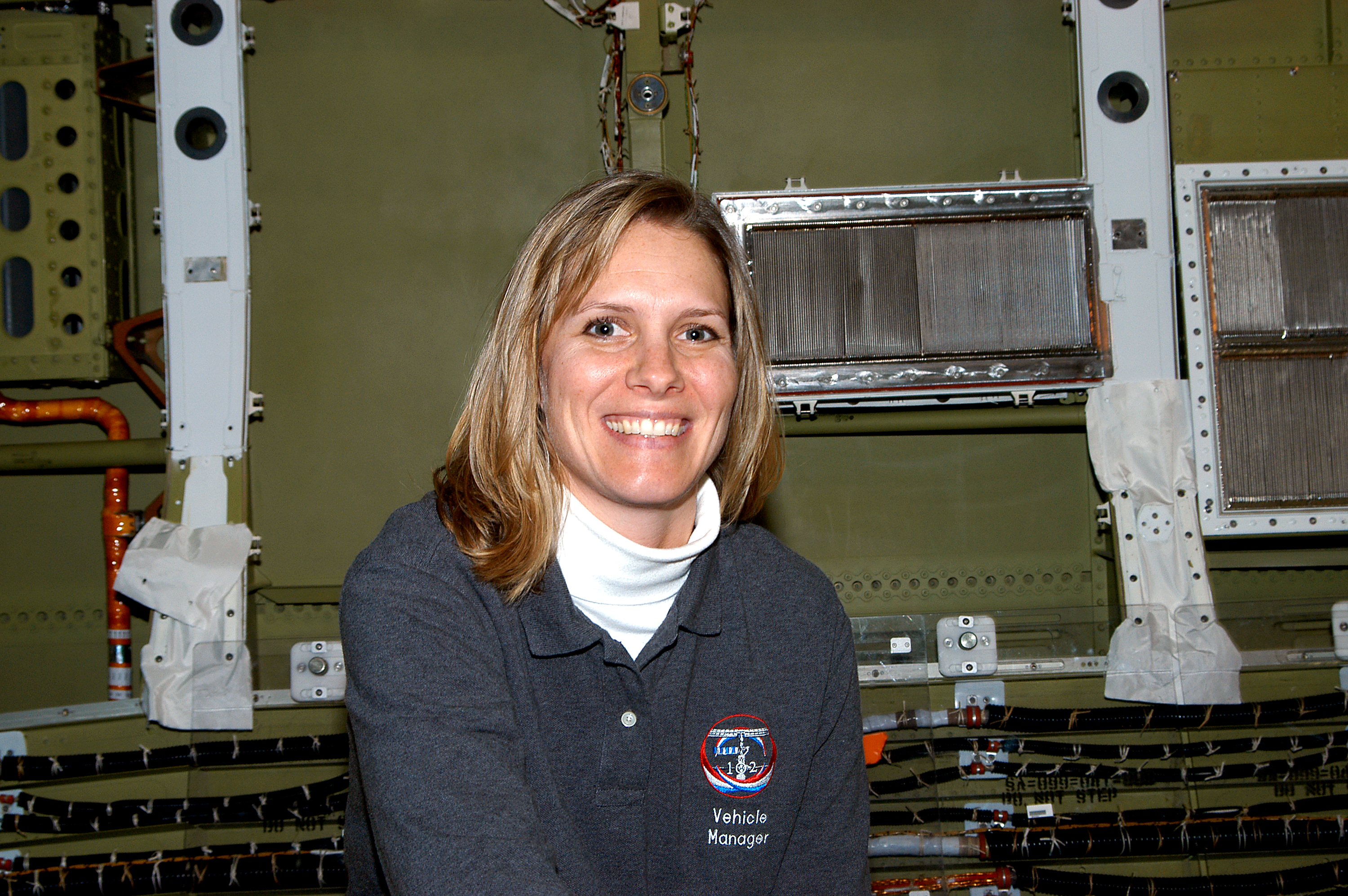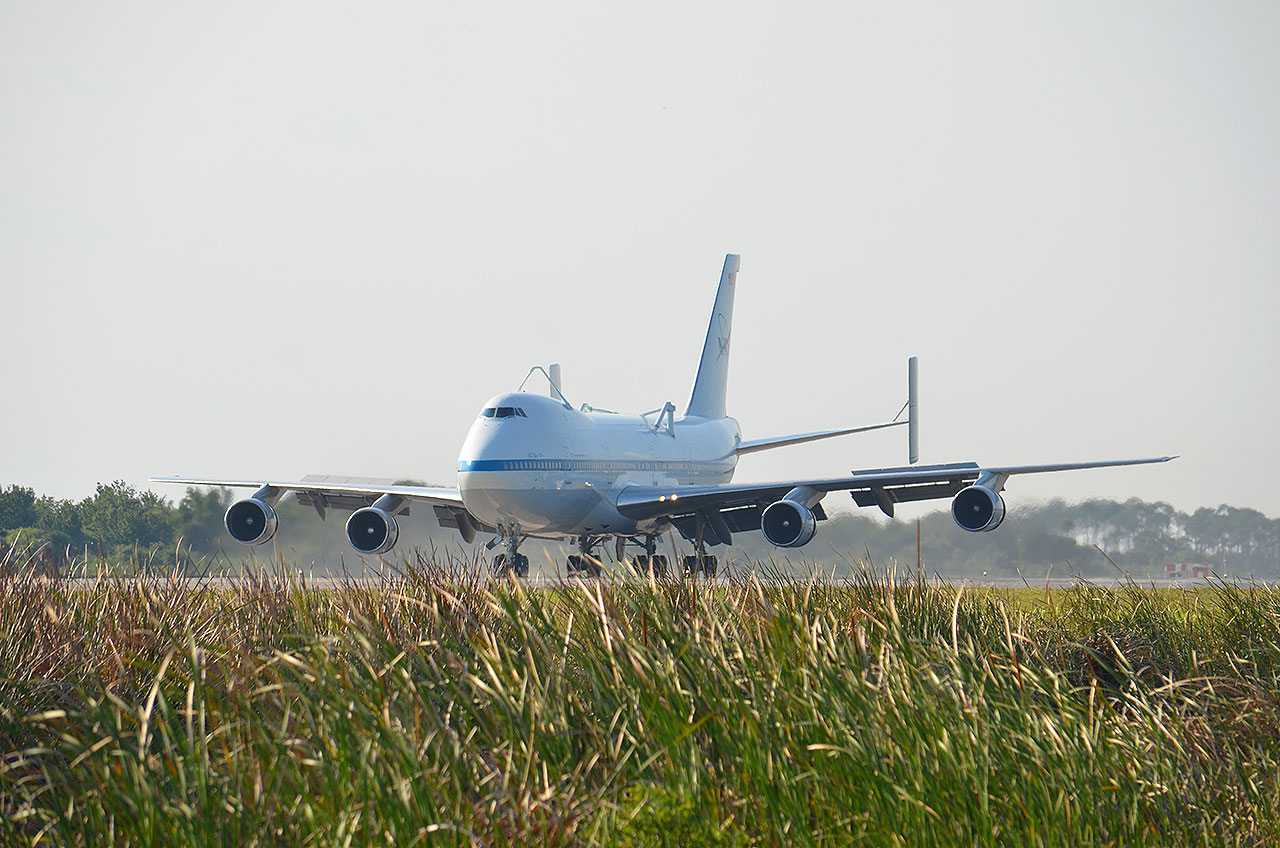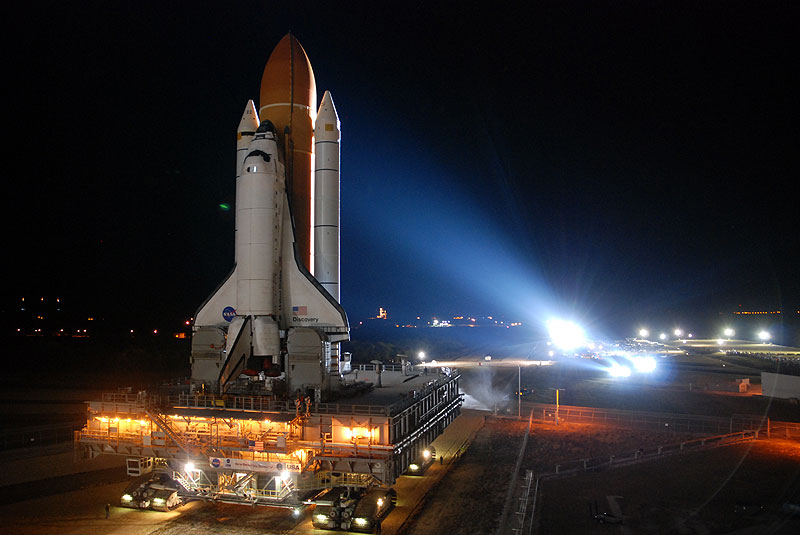Saying Goodbye to NASA's Shuttles: Q&A with Space Plane Wrangler Stephanie Stilson

This week, the space shuttle Discovery, NASA's most-flown space plane, will make its last flight, atop a modified aircraft that is delivering it to a museum for public display.
On April 17, Discovery is scheduled to depart NASA's Kennedy Space Center in Florida for Washington, D.C., where it will become the newest exhibit at the Smithsonian Institution's National Air and Space Museum.
The agency retired its 30-year space shuttle program in 2011, and Discovery, Atlantis and Endeavour, the three remaining orbiters in the fleet, plus the early prototype vehicle Enterprise, have found new homes at museums across the country.
From 2000 to 2011, Stephanie Stilson managed the shuttle Discovery's processing flow in between the orbiter's missions.
She is now overseeing the retirement of the vehicles from the Kennedy Space Center, and the delivery of Discovery, Enterprise, Atlantis and Endeavour to their new museum homes. SPACE.com recently caught up with Stilson to talk about the decommissioning process, the challenges of saying goodbye, and the legacy of the space shuttle program.
SPACE.com: Since you've worked on Discovery for so many years, how has this process been for you?
Stilson: I think a lot of people are expecting me to say I'm sad, and that this is an awful thing because Discovery is leaving. I so much enjoy the work we're doing and feel so fortunate that, although yes, we're going to give Discovery over, at least we're getting to be a part of this process of getting Discovery ready. And it's not just Discovery, we're getting all four vehicles ready, including Enterprise. I'm just very honored. [Photo Tour Inside Shuttle Discovery]
Breaking space news, the latest updates on rocket launches, skywatching events and more!
For us to not be the ones to be the caretakers of Discovery is a sad thing, and I'm sure once we get Discovery into the hangar at the Smithsonian and we walk away, that will definitely be a sad moment for me. But right now, I'm just focused on the milestones of accomplishing our work. We all want to make sure we deliver Discovery in the best shape possible and that's what we're really focusing on.
SPACE.com: Do you think that when it comes time to really hand over the shuttle, it'll be difficult or emotional?
Stilson: I think it will be when I finally get there. Fortunately I have become very familiar with Dr. Valerie Neal, who is the curator for the Smithsonian. She will be the new mother for Discovery. She's so excited and has so many great ideas about how to tell the story of the capabilities of this vehicle. I think that has really helped me, knowing that Discovery is going to someone like that makes me feel better. But when it comes time to say my job is done, that's definitely going to be hard moment for me. It may take a while for it to sink in, even after I leave Discovery and leave the Smithsonian.
For so long, I was able to see Discovery pretty much on a daily basis, except for when she was in orbit, so it's going to be quite a change for me and it's going to be something I'm going to have to get used to. But immediately after, I'll be focused on getting Enterprise up to New York and then Endeavour out to California, and then Atlantis to the visitor center, so there are plenty of things to keep me distracted.
SPACE.com: What has been the mood of the transition and retirement team?
Stilson: I think the main thing I would say about the team is they're very grateful that they're getting to be a part of this. The entire space shuttle team wanted to keep working on the space shuttles and keep them flying, and of course that wasn't possible. We now have the responsibility of getting the shuttles safely to the museums, so the team is proud to be a part of that. [Where to See America's Greatest Spaceships]
But there's a sad side as well because they know this is going to end soon. We're all not going to have a lot of time to do this, so we're very honored that we're a part of this smaller team, out of the larger NASA team.
SPACE.com: What kind of work was involved in the decommissioning process?
Stilson: The most important thing was to get the vehicle into a safe configuration to allow the general public to get up close and personal to the orbiters.
During the processing flow, if you wanted to be around the orbiters, you had to be certified because there were hazards associated with these vehicles flying in space. To prepare the vehicles for display, we had to go in and remove the hazards. These systems had to be de-serviced, or sometimes even removed from the ship, to ensure in the future there'll be no chance of anything leaking or out-gassing.
So that was the big undertaking that my team had to face and get through, and then the second thing would be to prepare the vehicle for display — to get it into a configuration that the museum wants it in for their displays. [NASA's Space Shuttle Program In Pictures]
SPACE.com: Discovery flew 39 missions and spent a total of 365 days — a full year — in orbit. Does the vehicle show its age?
Stilson: It definitely does. Over the years, it has held up very well. Discovery has the reputation of being the workhorse of the fleet. It was the vehicle that the agency counted on to bring us back to flight for both return-to-flight missions. Both times, Discovery has been the vehicle to get our country back to flying in space, so she's obviously been through a lot. When you look at her up close, she does look worn. There are discolorations and streaks from going from orbit back into our environment here.
And another thing we normally would have done if we were turning around and flying again is that we always have tiles that we repair. If we were going to fly Discovery again, we would repair the tiles or sometimes even replace them entirely. The Smithsonian wanted Discovery to look like it had rolled off the runway and into the hangar, so they wanted to keep all that so you could see the damage.
Discovery didn't actually have a lot of damage after the last mission, thank goodness, but now we'll use these things to educate the public on how fragile the shuttle really is. I think it's a great idea. A lot of people who aren't familiar with the vehicles think of it like an airplane, which has a skin that is hard to the touch. But space shuttles aren't like that. They're actually fragile on the outside, and I thought that was a great idea to let people see that up close.
SPACE.com: Is there anything physically that sets Discovery apart from the other shuttles?
Stilson: I don't know that I'd say there's anything on Discovery in particular, but for all of the orbiters, when you look at the black tiles on the belly of the vehicle, you can see they're all different colors. There's a range, from very dark black to light gray, and it has to do with the age of the tile. If it's a very bright, black tile, it's a brand new or relatively new tile. If they're very gray in color on the belly of the vehicle, they're older and could be original build tiles.
You can then see where majority of the tile work is performed because you can also see the streaks and effects of the plasma when the shuttle re-enters the atmosphere. Discovery flew 39 flights, so it has come through the atmosphere that many times. Also, the blankets themselves are white, but they look dirty. In some cases they look a little bit ragged. If we were going to fly in space again, we would make sure every single stitch was perfect. [Photos: Shuttle Discovery's Final Voyage]
So with this exhibit, you'll be able to see a bit of that and how it was when it returned from space. We didn't go and clean it and make it look bright white again, so it definitely does give it character. That's one thing for people who have seen Enterprise, because it looks very different on the outside. It doesn't have the blanket, so you can really get an appreciation of the thermal protection system on Discovery.
SPACE.com: So there are tiles on Discovery that have actually been there since the vehicle was built?
Stilson: Majority of the tiles are original build tiles, so that's surprising to a lot of people. When we were still flying, we'd replace at least 100 tiles in each processing flow. But keep in mind, that there are over 24,000 individual tiles, so 100 isn't that huge of a number. Also, where we're replacing them on the shuttle is usually in the same general area.
We have some liftoff debris, and we may get damage from a meteor, but that's pretty random. So, the damage coming back into the atmosphere is pretty standard, and we usually know where those repairs have to happen.
SPACE.com: What do you hope will be the legacy of Discovery and the space shuttle program?
Stilson: I think the vehicle itself and its capability is so impressive. It can launch in the vertical and land on the horizontal; it's able to dock with the International Space Station. So many great things have happened that it's going to be remembered for, and the Smithsonian and other locations will do a good job of telling people about that. I really hope and really feel confident that these exhibits will also show that anyone can be part of a team like this. Having gotten to work with each of the display sites, I really got that feel from all of them. They really want to paint that personal side of it. The displays say: here's this fantastic vehicle that has done these marvelous things. None of this would have come about if it weren't for the dedication of the entire team. There are some people who have worked their entire careers in the space shuttle program.
When future generations come to see these vehicles, they're really seeing the heart and soul of the people that built them and prepared them and got them to fly in space safely.
SPACE.com: Is there a mission or a specific moment while you were working on Discovery that particularly resonates with you?
Stilson: Of course we had a lot of great missions, but I think what stands out for me the most is the return-to-flight mission after the Columbia accident. It's memorable for obvious reasons, because we were able to get back and prove that we had found the problem and fixed the problem. I'm fortunate that my team was involved in making that happen, but more so because I knew what it took to get to that point where we got to fly again. [Most Memorable Space Shuttle Missions]
During those three years, we incorporated new modifications so that we could be the best that we could be. For me, the launch of that mission as phenomenal, and obviously the landing was the proof in the pudding that we could do this again and do it safely.
SPACE.com: Finally, I have to ask, do you have a favorite shuttle?
Stilson: Discovery, of course. It has been something that's actually been really unique to me. Obviously Discovery is my favorite. I represent Discovery and the team. But now I'm getting to work with Atlantis, Endeavour and Enterprise, and I've been loving these vehicles as well. It has been fun getting to learn about those missions too.
You can follow SPACE.com staff writer Denise Chow on Twitter @denisechow. Follow SPACE.com for the latest in space science and exploration news on Twitter @Spacedotcom and on Facebook.

Denise Chow is a former Space.com staff writer who then worked as assistant managing editor at Live Science before moving to NBC News as a science reporter, where she focuses on general science and climate change. She spent two years with Space.com, writing about rocket launches and covering NASA's final three space shuttle missions, before joining the Live Science team in 2013. A Canadian transplant, Denise has a bachelor's degree from the University of Toronto, and a master's degree in journalism from New York University. At NBC News, Denise covers general science and climate change.




